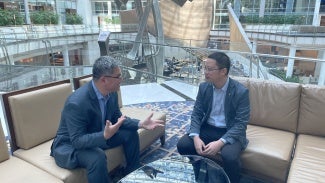
Practicing architecture overseas
AIA’s Global Practice Committee chair discusses the advantages and challenges of working internationally and offers three tips to consider before making a move.
With proper guidance, practicing abroad can be within reach for architects at any career stage. AIA's Global Practice Committee Chair Li Ren, AIA, offers advice for architects considering overseas pursuits. Ren is an
architect and associate at Perkins Eastman in Dubai, where he specializes in the design of hospitality, senior living, and master plans. His approach to design is sustainable and inclusive, seeking to involve the community in the design process to enhance both the quality of the design and social engagement. In this Q&A, Ren shares how AIA can play a vital role in the transition to an international career, and discusses his journey into the global arena.

Could you start by telling us about yourself? Where are you from, and where are you currently based?
Li Ren (LR): I was born and raised in China. I completed my undergraduate studies there before pursuing graduate studies in the United States at the University of Minnesota. After earning my Master of Architecture degree in 2015, I moved to Washington, D.C., to embark on my career as a designer specializing in affordable housing and senior living. In early 2020, I joined the Perkins Eastman DC office. By the end of 2022, I transitioned to the Perkins Eastman Dubai office, where my focus shifted to hospitality and master plan design. Additionally, I hold a part-time position as a visiting professor at the American University in the Emirates, where I teach sustainable design and professional practice. Since 2024, I've had the privilege of serving as the Vice President of AIA Middle East and chairing the AIA Global Practice Committee.
As a professional trained in the U.S., what are the advantages and challenges you've experienced working internationally?
LR: Collaboration, licensure, and professional networks have been significant advantages stemming from my U.S. education and practice background. My experience with international collaboration at Perkins Eastman's D.C. office provided valuable insights into global workflows. Upon relocating to Dubai, I was overwhelmed by culture shock. My colleagues and familiarity with the Perkins Eastman framework eased my transition, fostering a sense of belonging. Holding a U.S. architect license proved advantageous, as it is widely recognized in the Middle East, where formal licensure systems are still evolving. Additionally, my AIA membership facilitated networking and integration into the local architectural community, aiding in a smooth transition to my new role.
What motivated you to pursue a career abroad?
LR: Several factors influenced my decision, including professional opportunities, personal considerations, and academic engagement. The Middle East, particularly Dubai, is currently experiencing rapid growth in construction and architecture, presenting exciting career prospects. Joining the Perkins Eastman Dubai office allowed me to lead a diverse team dedicated to serving the local community—a fulfilling opportunity for me. On a personal level, Dubai's cultural diversity and strategic location appealed to me, offering convenient travel options and facilitating visits to my family in China. Moreover, my interest in academic research and engagement in architecture led me to explore teaching opportunities, which the Dubai golden visa enabled me to pursue.
Have you encountered any difficulties in securing a work visa?
LR: Residency rights played a significant role in my decision. As my U.S. work visa was nearing expiration, and obtaining permanent residency there was becoming increasingly difficult, Dubai offered a more straightforward path. I received a long-term permanent residency (Golden Visa) within six months, which allows me the freedom to teach part-time at a local university and pursue personal business endeavors after office hours. Currently, the UAE government offers the Golden Visa for “creative talent,” which is a great opportunity for architects. An AIA membership, a U.S. architect license, a strong portfolio, awarded projects, and media reports are sufficient to pursue this visa.
As the chair of the AIA Global Practice Committee, what initiatives does AIA have in place to support members seeking careers abroad?
LR: I joined the AIA Global Practice Committee in 2023 and am serving as the committee chair in 2024. There are two initiatives I have implemented to support AIA members' global practice. The first is the Global Practice Primer, a guideline book first published in 2017, covering a wide range of topics from tax, business, and legal issues to cultural understanding, project delivery, technology, and sustainability. I led the rewrite of the sustainability chapter and the update of the technology chapter, with plans to publish the new version in 2024. The second initiative is the O-1 visa policy study and advocacy. As obtaining the U.S. H1B work visa becomes increasingly challenging each year, I am leading the AIA Global Practice Committee to study the O-1 visa as an alternative for immigrant architects, advocating for cross-border global practice, and reinforcing AIA's leadership in the architecture industry.
What’s your future career plan?
LR: My plan involves continuing to grow and excel in architecture while expanding my impact on the global stage. I aim to advance in leadership roles within AIA and other professional organizations, contributing to the profession's advancement globally. I plan to lead projects prioritizing sustainability, innovation, and community impact, setting new standards in architectural design and practice. I will further my involvement in academia, sharing my knowledge with the next generation of architects, and contributing to research and publications. Additionally, I will advocate for and support the global practice of architecture through initiatives like the Global Practice Primer and visa policy studies, ensuring architects can navigate international careers successfully. Building and nurturing a professional network, mentoring young architects, and fostering a collaborative environment within the global architectural community is essential. Finally, I will engage in lifelong learning and professional development to stay at the forefront of industry trends and technologies, ensuring my skills and knowledge remain current and relevant.
Li Ren’s Top Three Tips to consider before working overseas:
1. Gain domestic experience first: Many U.S. firms have international business and projects, so joining these teams and working on international projects will give you a sense of international collaboration and workflow.
2. Travel to the country first: Living conditions and other personal life situations are important, so traveling to the new country and staying there for one or two weeks is a good choice. Experiencing the local weather, food, cultural and social environment, and cost of living is crucial for your international practice and life.
3. Stay connected through AIA: Take advantage of the AIA platform. You can make local connections through AIA International before departing and stay connected with architects who share a similar background. Most importantly, AIA International can be your first step to local engagement, helping you expand your network and quickly adapt to the new chapter of your career.
